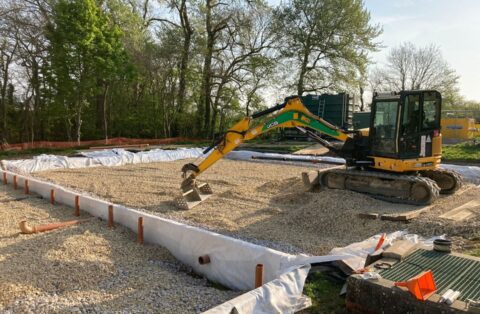Project in numbers
600 square metres of reed beds to treat effluent
3,5k reeds planted by hand
The need
A water recycling centre in the West of England, consisting of 3 reed beds across 600 square metres, treats effluent from adjacent properties before discharging safely back it into the watercourse. If not maintained effectively, the beds can become overgrown and inefficient. In this case, the beds were also partially blinded with sediment, which was preventing the effluent from filtering effectively and safely.
The solution
We carried out trial digs which highlighted the need to replace the reed bed liners. In many cases these had been damaged by self-sown trees and fallen coping stones and needed urgent attention.
All remedial works were carried out following ecological consents. A temporary water treatment facility was installed, bypassing the reed beds and allowing them to be drained. We cordoned off the adjacent watercourse to minimise environmental impact, and bog mats were used to protect the surrounding areas.
Following a CAT scan of the site, our engineers carefully excavated the beds to remove the reeds and rootstock. All discarded plant material went to green-waste disposal.
Pipework between the beds was taken up, retaining for reuse. The stone was then excavated and removed. The existing liner and geotextile were taken out, and the clay base recompacted to receive the new base geotextile layer and then the EPDM (synthetic rubber) liner. Inlet and outlet pipe penetrations were welded and sealed.
After a successful 5-day test, an additional protective layer of geotextile was placed on the liner prior to reinstalling the filter media. Replacement stone was laid and levelled, and aeration pipes and inlet/outlet pipework were installed.
Finally, approximately 3,500 Phragmites australis (‘common reeds’) were planted by hand, at a rate of 6 to 8 per metre squared.
The benefits
- The project has successfully restored the optimal processing efficiency of the reed beds which provide effective tertiary treatment for at least another 10 years before the reeds will need replacing and at least another 20 before the liner will require further maintenance
- Reed beds provide environmentally clean, cost-effective ecologically beneficial alternative to expensive, energy-intensive traditional wastewater treatment options. They not only operate without the use of power, but also help to sequester carbon from the atmosphere, and provide large volume of storm water storage and processing without the requirement for built infrastructure, helping to alleviate the effects of flooding and drought. Reed beds offer a rich habitat for wildlife and increase biodiversity helping to protect the environment for future generations











